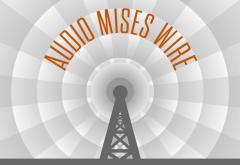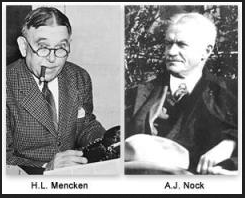Most people believe lending is associated with money. But there is more to lending. A lender lends savings to a borrower as opposed to “just money.” Let us explain. Take a farmer, Joe, who has produced two kilograms of potatoes. For his own consumption, he requires one kilogram, and the rest he agrees to lend for one year to another farmer, Bob. The unconsumed kilogram of potatoes that he agrees to lend is his savings. By lending a kilogram of potatoes to Bob, Joe has agreed to give up for one year his ownership over these potatoes. In return, Bob provides Joe with a promise that after one year he will repay 1.1 kilograms of potatoes, with the 0.1 kilogram constituting interest. Note that the existence of savings is the precondition for lending (there must be
Topics:
Frank Shostak considers the following as important: 6b) Mises.org, Featured, newsletter
This could be interesting, too:
Nachrichten Ticker - www.finanzen.ch writes Die Performance der Kryptowährungen in KW 9: Das hat sich bei Bitcoin, Ether & Co. getan
Nachrichten Ticker - www.finanzen.ch writes Wer verbirgt sich hinter der Ethereum-Technologie?
Martin Hartmann writes Eine Analyse nach den Lehren von Milton Friedman
Marc Chandler writes March 2025 Monthly
 Most people believe lending is associated with money. But there is more to lending. A lender lends savings to a borrower as opposed to “just money.” Let us explain.
Most people believe lending is associated with money. But there is more to lending. A lender lends savings to a borrower as opposed to “just money.” Let us explain.
Take a farmer, Joe, who has produced two kilograms of potatoes. For his own consumption, he requires one kilogram, and the rest he agrees to lend for one year to another farmer, Bob. The unconsumed kilogram of potatoes that he agrees to lend is his savings.
By lending a kilogram of potatoes to Bob, Joe has agreed to give up for one year his ownership over these potatoes. In return, Bob provides Joe with a promise that after one year he will repay 1.1 kilograms of potatoes, with the 0.1 kilogram constituting interest. Note that the existence of savings is the precondition for lending (there must be savings first). Savings must fully back lending.
What we have here is an exchange of a kilogram of present potatoes for 1.1 kilograms of potatoes in one year. Both Joe and Bob have entered this transaction voluntarily because they both have reached the conclusion that it would serve their objectives.
The introduction of money is not going to alter the essence of what lending is all about. Instead of lending a kilogram of potatoes, Joe is likely to exchange his kilogram of potatoes for money, let us say for $10. Joe may now decide to lend his money to another farmer, John, for one year at the going interest rate of 10 percent. Observe that the introduction of money did not change the fact that savings precede the act of lending. When a saver lends money, what he in fact lends to a borrower is final consumer goods that he did not consume.
Savings support individuals in the various stages of production; hence, savings are the heart of economic growth. The lending of savings fulfills an important role in the process of wealth generation. By lending his savings to Bob, Joe provides a means of sustenance to Bob. This in turn makes it possible for Bob to engage in a wealth-generating activity.
Introducing Banking
Rather than himself searching for potential borrowers, Joe could approach an organization that specializes in finding borrowers. This organization is a bank. The bank specializes in finding borrowers for individuals that are willing to lend their savings. Banks also specialize in finding lenders for individuals that are willing to borrow. Banks thus fulfill the role of an intermediary. (Note that banks can also engage in direct lending by using their own equity funds or by borrowing the required funds.)
In addition, the bank also provides a facility for storing money in demand deposits. An individual can exercise his demand for money by holding the money in his wallet, holding it at home, or storing it in a demand deposit, which is provided by the bank. By storing his money in a demand deposit, the individual retains an unlimited claim over the deposited money—it is his possession.
If the owner of the demand deposit were to decide to lend part of the stored money, then he would likely inform the bank by transferring part of the money stored in the demand deposit to a term deposit.
Banks offer various lending options to potential lenders such as Joe through various term deposits. The bank can offer Joe the option of lending his money from a very short period to a very long period by allowing Joe to place his money in corresponding term deposits.
For instance, if Joe decides to lend five dollars for one year at the market interest rate, he could transfer this amount to a one-year term deposit. This also means that Joe has agreed to relinquish ownership over the five dollars for one year. Now it is up to the bank to find a suitable borrower. Observe that savings fully back lending here. Trouble emerges once banks start to engage in lending without support from savings.
Lending Unbacked by Savings Results in Economic Impoverishment
Ordinary lenders will find it difficult to lend something that they do not have. However, things are different once we introduce into our analysis lending by banks that is not supported by savings— lending out of “thin air.”
If Joe were to decide to lend five dollars for one year, we would have a transfer of five dollars from Joe’s demand deposit to a one-year term deposit. The money in the one-year term deposit can then be lent out for one year. (The one-year term deposit of five dollars backs the one-year loan of five dollars here).
Consider a case where Bob approaches Bank A for a loan of five dollars for one year. Bank A accommodates this request and lends Bob the money by opening a newly established demand deposit for Bob with a balance of five dollars. Also, note that we did not have here a transfer of five dollars from the holders of demand deposits such as Joe to the one-year term deposit. A transfer of money from a lender such as Joe does not back the demand deposit established for Bob. The loan to Bob is unbacked by savings. Bank A has generated the five-dollar loan out of “thin air.” The bank here established a demand deposit without the backing of savings. (Contrast this with when Joe opens a demand deposit to the tune of $10 by saving a kilogram of potatoes and selling it for $10.)
When Bob the borrower uses the unbacked money, which Bank A generated out of “thin air,” Bob is engaging in an exchange of nothing for something. This is because savings do not back the money—it is empty money. In an unhampered market economy, a bank runs the risk of bankruptcy by issuing loans out of “thin air.” According to Murray N. Rothbard,
As soon as the new money ripples out to other banks—the issuing bank is in big trouble. For the sooner and the more intensely clients of other banks come into picture, the sooner will severe redemption pressure, even unto bankruptcy, hit the expanding bank.
The reason for the likely bankruptcy is that the bank issuing loans out of “thin air” does not have enough money to clear its checks during the interbank settlements. Consequently, in an unhampered market economy, without a central bank, competition between banks is likely to minimize lending out of “thin air.” On this Ludwig von Mises wrote:
People often refer to the dictum of an anonymous American quoted by Tooke: “Free trade in banking is free trade in swindling.” However, freedom in the issuance of banknotes would have narrowed down the use of banknotes considerably if it had not entirely suppressed it. It was this idea which Cernuschi advanced in the hearings of the French Banking Inquiry on October 24, 1865: “I believe that what is called freedom of banking would result in a total suppression of banknotes in France. I want to give everybody the right to issue banknotes so that nobody should take any banknotes any longer.”
It must be realized that the likelihood of bankruptcy increases when there are many competing banks. As the number of banks increases and the number of clients per bank declines, the chances that clients will spend money on goods from individuals banking with other banks will increase. This in turn will increase the risk of a bank being unable to clear its checks if it begins to issue loans out of “thin air.”
Conversely, as the number of competing banks declines (that is, as the number of clients per bank rises), the likelihood of bankruptcy diminishes. In the extreme case of one bank, it can practice lending out of “thin air” without any fear of bankruptcy, the reason being that the bank does not have to clear its own checks and hence will not bankrupt itself.
Lending out of “thin air” is likely to become a sustainable occurrence in the framework of a central bank. In this framework, banks can be seen as branches of the central bank. The central bank, by means of daily money supply management (i.e., monetary pumping), prevents banks from bankrupting each other. Hence, banks under a central bank framework can lend unlimited amounts out of “thin air” without going bankrupt.
According to Rothbard,
The Central Bank can see to it that all banks in the country can inflate harmoniously and uniformly together…. In short, the Central Bank functions as a government cartelizing device to coordinate the banks so that they can evade the restrictions of free markets and free banking and inflate uniformly together.
Lending Out of “Thin Air” Encourages Unproductive Activities
When loaned money is fully backed by savings, it is returned to the original lender on the day of a loan’s maturity. Bob—the borrower of five dollars—will return the borrowed sum and interest to the bank on the maturity date. The bank in turn will return the five dollars plus interest, adjusted for bank fees, to Joe the lender. The money makes a full circle and goes back to the original lender. Note again that the bank here is just a facilitator; it is not a lender, so it returns the borrowed money to the original lender.
In contrast, when lending that originates out of “thin air” is returned to the bank on the maturity date, this leads to a withdrawal of money from the economy (i.e., to a decline in the money supply), the reason being that there was never a saver/lender, since this lending emerged out of “thin air.” Savings did not support the newly formed demand deposits in this case. When Bob repays the five dollars, the money leaves the economy, since there is no original lender to whom the loaned money should be returned.
Observe that the $5 loan out of “thin air” is a catalyst for an exchange of nothing for something. It serves as a platform for unproductive activities that prior to the generation of a loan out of “thin air” would not have emerged. As long as banks continue to expand lending out of “thin air,” such activities will continue to flourish.
Because of the continuous expansion in lending out of “thin air,” the pace of wealth consumption will start to surpass the pace of wealth production. The positive flow of savings will be arrested and savings will decline.
Consequently, the performance of various activities will start to deteriorate and banks’ bad loans will pile up. In response to this, banks will curtail their lending out of “thin air,” triggering a decline in the money supply. A decline in the money supply will begin to undermine various nonproductive activities, touching off an economic recession.
Some economists such as the late Milton Friedman believe that once the money supply starts to decline, the central bank should pump money into the economy to prevent a slump. An economic slump, however, is not caused by a decline in the money supply, but by the shrinking pool of savings resulting from the previous easy monetary policies. The shrinking pool of savings leads to a decline in economic activity, which forces a decline in lending out of “thin air,” which in turn results in a decline in the money supply.
Even if the central bank were to prevent the decline in the money supply—for instance, by means of “helicopter money”—this could not prevent an economic slump if the pool of savings is declining, since the heart of economic growth is the expanding pool of savings. Banks’ ability to generate lending out of “thin air” comes from the central bank’s easy monetary policies. Without a central bank, the likelihood of banks practicing lending out of “thin air” would be very low.
Conclusion
Banks facilitate the flow of savings by introducing the “suppliers” of savings to the “demanders.” By playing the role of intermediaries, banks are an important factor in the process of wealth formation. Once banks abandon their role as intermediaries and start to lend money unbacked by savings, however, this sets in motion the menace of the boom-bust cycle and economic impoverishment. It is not possible to increase genuine credit without increasing savings.
Tags: Featured,newsletter








